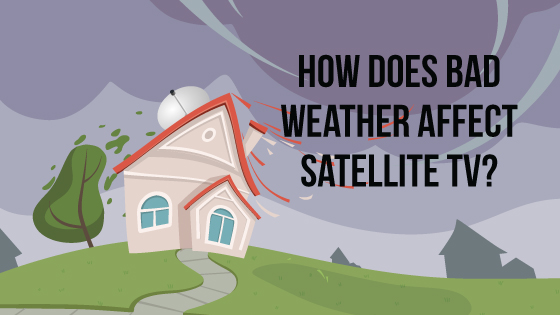If you’re thinking about a new TV service, you may be curious to know how does bad weather affect satellite TV? The truth is that certain weather conditions are harder on a satellite dish than others, but there are things you can do to improve your reception at any time.
About Satellite Signals
To better understand the answer to the question “how does bad weather affect satellite TV?” we should look at how satellite dishes work, and the weak points of the system.
DIRECT TV Satellite TV dishes transmit their signals using the Ku-Band, or Kurtz Under Band, which exists underneath the K-band. The Ku-band operates at a higher frequency, which makes it susceptible to being dispersed by moisture, such as rain or humidity.
Even clouds can affect this frequency during lousy weather, and the Ku-band can penetrate water found in the atmosphere most of the time. Most satellite dishes used by consumers have some error correction, as lousy weather or moisture is not unexpected.
This error correction works to fix any intermittent signals that the satellite dish is trying to pick up, and this can be very useful during a storm or when the humidity is very high.
How Rain and Bad Weather Affect Your Satellite
Rain and other adverse weather can affect satellite signal transmission, and even the most secure and accurately positioned satellite dish will suffer signal loss at some point. Rain, in particular, is hard on satellites as the individual raindrops can absorb or deflect the signals transmitting between your dish and the satellite.
Another thing that can happen is that the raindrops hitting the surface of your satellite dish can cause the electromagnetic waves to scatter around or refract, which degrades the signal in both directions.
Smaller dishes or mini-dishes are often better designed and better able to maintain a signal during rain or other adverse weather. More substantial dishes are a better option if you are in an area with heavy rains as their larger size makes them better able to compensate for signal loss.
So, if you live in an area with monsoons or other heavy rains that come around frequently, you’ll want to look at a well-designed mini-dish intended for bad weather, or a more substantial dish that has enough surface area to collect a signal no matter how hard the rain.
Other forms of bad weather are harmful to the overall quality of your satellite signal and include conditions such as:
- Ice
- Snow
- Wind
These kinds of weather conditions are common in large portions of North America and other parts of the world where DISH TV is the best option. Snow and ice can affect the signal that your satellite receives in much the same way as rain, but the wind works differently.
Wind can cause small movements, which can cause the satellite dish to become misaligned over time. Areas where frequent winds are present such as the coast or very flat regions are more likely to suffer from this problem.
Usually, any problems that you experience with your satellite that are weather-related tend to come from a combination of bad weather and maybe more intense during certain times of the year.
Possible Solutions
Now that we know the answer to “how does bad weather affect satellite TV?” we can talk about options for bolstering poor reception when the weather is less than ideal. Some of these solutions you can implement with little effort while others may take more work.
Here are some possible solutions homeowners can try when they are experiencing poor reception during bad weather:
- Try mounting a transparent square of fiberglass material in front of your satellite dish especially if the dish mounts to your house or another covered area
- Make sure your satellite dish is in a location that is a dry area where water isn’t dripping on it such as under a tree
- If you suspect your satellite dish has moved due to high winds, you can try realigning it yourself but calling a professional might be a better option
- Spray the satellite dish with a non-stick spray such as the kind used in cooking, so the surface sheds water
Some of these solutions will last longer than others, and some of them will take longer to implement, such as moving the location of your satellite dish.
Keep in mind that if you plan to spray your satellite dish with cooking spray that you may need to reapply this spray frequently depending on the weather. The guideline here is once after each rain, or every one to three months, depending on the weather in your location.
If your satellite dish is in an area where water is dripping, such as the edge of your roof or under a tree, you could be sabotaging your level of reception. Moving your satellite dish might take a bit more time, but chances are you’ll see a significant improvement.
Lastly, there is a lot of material available online about how to correct the position of your satellite yourself, and you can try these options if you wish; however, a trained professional has the tools and knowledge needed to align your dish precisely.
If you live in an area where there’s a lot of snow and ice accumulation, you may want to make sure that your satellite dish has a built-in heater. If your dish does have a heater, but there is still ice and snow build-up, you’ll want to make sure the dish resides in a location that helps to minimize exposure to water, ice, and snow.
Final Thoughts
Understanding the basics of how your satellite dish works will help you to figure out when the weather is responsible for your poor reception.
Areas that experience frequent and hard rain will have more reception issues in many cases
Locations that see ice and snow may not have as many problems with reception but may require a heater to keep the satellite dish clear
Keeping your satellite dish clean and dry is the best way to ensure proper reception, and straightforward solutions like non-stick spray can help your dish shed water that may be degrading the signal.
It’s also best if your satellite dish is placed a reasonable distance away from trees, and where water runs off the edge of the roof of your house.




